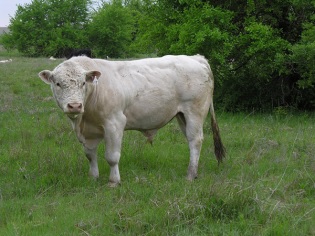
Agricultural News
Buying Known Bull Genetics Adds Value
Thu, 01 Oct 2015 11:39:10 CDT

Contributed by Samuel Roberts Noble Foundation Agricultural Economist Consultant Steve Swigert
One of the most important management decisions for a cattle operation is what bull to buy. When cattle producers make bull purchases, several factors should be considered: number of bulls, type, acquisition time, age, source, quality and cost.
For this analysis, it is assumed the purchaser can do a good job of analyzing a bull's phenotype (physical characteristics) prior to purchase. If a producer does not have the necessary skills to visually evaluate the bull, the producer should either ask for help or purchase from operations or sales with breeding soundness or bull health guarantees.
How many bulls should be purchased is directly related to cow herd size. The typical bull-to-cow ratio is one bull to 25 or 30 cows but can vary by pasture size, property roughness and bull age. Producers with small cow herds are challenged to keep bull cost down while making sure all cows get bred. Having only one bull increases the risk of open cows for small herds because the bull might have or develop a breeding problem. With high value calves, an operation cannot generally afford to have open cows.
When selecting the type of bull to purchase, bull genotype (genetic makeup) should be selected to complement a cow herd to produce desirable calves. Knowing the genetic potential of the calves helps a producer determine whether to retain ownership past weaning. Uniform calves (both type and color) command higher prices than non-uniform calves at sale time.
Planning ahead usually results in a better selection of bulls with better genetics. Buying earlier gives the bull time to acclimate to the region, the ranch and the handling procedures of the operation. Also, buying early allows for additional growth of 12- to 18-month old bulls, which is the typical age of many bulls in today's market. For spring-calving cow herds, this would mean purchasing bulls in the fall when the number of bulls needed is not yet fully determined. When bulls test infertile during a breeding soundness exam prior to the breeding season or are injured during the breeding season, replacement bulls that match the existing bull battery must be obtained as soon as possible.
In determining where to buy bulls, a cow/calf producer should look for seedstock producers with good reputations, the breed needed, quality genetics and the documentation necessary to validate genetic quality, such as actual performance and expected progeny differences (EPDs).
The bull's quality and cost are commonly linked; a bull that can sire heavier calves should be worth more. The best way to determine a bull's value is potential revenues returned to the operation in the form of calf weight.
Once analyzing the numbers, visually inspect the bulls and rank according to priority. Then decide how much the bulls are worth. Three bull investment scenarios are provided in Tables 1 and 2: Bull 1 is a typical bull purchased out of a sale barn to just get the cows pregnant; Bull 2 is purchased from a neighbor or friend and could be of known parentage with individual animal performance available; Bull 3 is purchased from a reputable breeder with known genetics, and individual performance information and EPDs are available.
Table 1 shows the total annual economic bull costs per cow for each bull, assuming each performs for five years. From the analysis, the difference between Bull 1 and Bull 2 is $12.69 per cow, which for a 550-pound calf is $2.30 per hundred weight. There is a $31.09 per cow difference between Bull 1 and Bull 3, which on a 550-pound calf is $5.65 per hundred weight. Table 2 shows examples of how these investments could affect an operation. Tables 1 and 2 demonstrate the performance differences in subsequent calf crops and potential incomes related to purchasing bulls based on EPDs and pedigrees.
It usually pays to purchase good genetics. While every operation might not receive an increase in performance as projected above, there are operations that have seen greater increases. With a high value of gain, relatively small differences in marginal cost relate to significant differences in marginal return. When considering performance differences, bulls that increase calf growth performance are worth a lot more than average bulls and typically do not cost as much as they are worth.
WebReadyTM Powered by WireReady® NSI
Top Agricultural News
More Headlines...



















